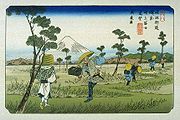
Konosu-shuku
Encyclopedia

69 Stations of the Nakasendo
The are the rest areas along the Nakasendō, which ran from Nihonbashi in Edo to Sanjō Ōhashi in Kyoto. The route stretched approximately and was an alternate trade route to the Tōkaidō.-Stations of the Nakasendō:...
of the Nakasendō
Nakasendo
The , also called the , was one of the five routes of the Edo period, and one of the two that connected Edo to Kyoto in Japan. There were 69 stations between Edo and Kyoto, crossing through Musashi, Kōzuke, Shinano, Mino and Ōmi provinces...
. It is located in the present-day city of Kōnosu, Saitama Prefecture
Saitama Prefecture
is a prefecture of Japan located in the Kantō region of the island of Honshu. The capital is the city of Saitama.This prefecture is part of the Greater Tokyo Area, and most of Saitama's cities can be described as suburbs of Tokyo, to which a large amount of residents commute each day.- History...
, Japan
Japan
Japan is an island nation in East Asia. Located in the Pacific Ocean, it lies to the east of the Sea of Japan, China, North Korea, South Korea and Russia, stretching from the Sea of Okhotsk in the north to the East China Sea and Taiwan in the south...
.
History
Until 1602, Kōnosu-shuku was located in the present-day city of KitamotoKitamoto, Saitama
is a city located in Saitama Prefecture, Japan.As of June 1, 2011, the city has an estimated population of 70,237 with 27,714 households and a population density of 3,527.42 persons per km²...
, but when the Nakasendō was established during the Edo period
Edo period
The , or , is a division of Japanese history which was ruled by the shoguns of the Tokugawa family, running from 1603 to 1868. The political entity of this period was the Tokugawa shogunate....
, the post town was moved north to its current location. The original village’s name was changed to Moto-kōnosu (本鴻巣村 Motokōnosu-mura), while the original rest area’s name was changed to Moto-shuku (本宿). During the Meiji period
Meiji period
The , also known as the Meiji era, is a Japanese era which extended from September 1868 through July 1912. This period represents the first half of the Empire of Japan.- Meiji Restoration and the emperor :...
, the rest area’s name was again changed to Kita Moto-shuku (北本宿), which was adopted as the name of its train station, which was opened in 1928, and the village was renamed Kita Moto-shuku ten years later.
It has been said that Kōnosu-shuku was moved because it was too close to the following Okegawa-juku, but Okegawa-shuku is closer to Ageo-juku than it ever was to Kōnosu-shuku. It is also assumed that Kōnosu-shuku was moved because it was too far from Kumagai-shuku
Kumagai-shuku
was the eighth of the sixty-nine stations of the Nakasendō. It is located in the present-day city of Kumagaya, Saitama Prefecture, Japan.-History:Kumagai-shuku was the first training center for Buddhists in the Kantō region and had two honjin during the Edo period, but was still a rather small post...
, but the real reason is unclear today.
When Kōnosu-shuku was established in its new place, the Nakasendō was not the only road running through it. It also had roads connecting to Matsuyama (present-day Higashimatsuyama
Higashimatsuyama, Saitama
is a city located in Saitama Prefecture, Japan.As of April 1, 2011, the city has an estimated population of 89,647 and a population density of 1,372.22 persons per km²...
), Nin (present-day Gyōda
Gyoda, Saitama
is a city in Saitama Prefecture, Japan.As of April 1, 2011, the city has an estimated population of 87,089, with 33,570 households and a population density of 1,292.70 persons per km²...
), and Kisaichi (present-day Kisai
Kisai, Saitama
was a town located in Kitasaitama District, Saitama, Japan.As of 2003, the town had an estimated population of 20,105 and a density of 702.97 persons per km². The total area was 28.60 km²....
). Relative to other stations along the Nakasendō, it was a rather large station. There was one honjin
Honjin
thumb|250px|The honjin at [[Inaba Kaidō]]'s [[Ōhara-shuku]]. is the Japanese word for an inn for government officials, generally located in post stations during the later part of the Edo period.-Evolution of Honjin:...
, two sub-honjin, and 58 other minor inns.
At the entrance to the post station is Shōgan-ji, a large temple in the Jōdoshū sect
Pure Land Buddhism
Pure Land Buddhism , also referred to as Amidism in English, is a broad branch of Mahāyāna Buddhism and currently one of the most popular traditions of Buddhism in East Asia. Pure Land is a branch of Buddhism focused on Amitābha Buddha...
.

